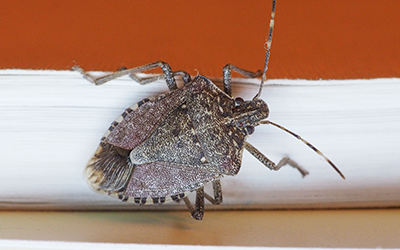
Stink bugs have recently made their mark as one of Iowa’s newest invasive species. These putrid pests first arrived in the US from Southeast Asia in 1998, and since then, they’ve managed to spread to nearly every state.
If it seems like your home is dealing with more stink bugs than usual, you’re not imagining things—they do have a preference for certain homes over others. In this guide, the specialists at Springer Professional Home Services will delve into what attracts these pesky bugs to your home, why they might find your place particularly inviting, and offer effective strategies for getting rid of them.
What Do Stink Bugs Look Like?
Stink bugs have a distinctive appearance that makes them relatively easy to identify. They are usually about half an inch to one inch long and have a somewhat shield-shaped body. Their color can range from brown to green, often with a mottled pattern that can vary from one species to another. The most recognizable feature is their triangular-shaped scutellum, the small, triangular shield on their back, which contributes to their unique look. Their appearance, combined with their tendency to invade homes, makes them quite memorable.
Are Stink Bugs Dangerous?
Stink bugs, while certainly a nuisance, are not considered dangerous to humans. They don’t bite or sting, and they aren’t known to carry diseases that could harm you or your pets. However, their presence can be quite bothersome.
They tend to invade homes in large numbers, especially during the colder months, which can lead to an unpleasant experience as they scatter throughout your living space. Their primary threat lies in their tendency to become a persistent nuisance rather than a health hazard.
Why Do Stink Bugs Stink?
The unpleasant odor of stink bugs is a defense mechanism they use to ward off predators. When threatened, stink bugs release a foul-smelling chemical from glands located on their abdomen. This smell acts as a deterrent to potential threats, signaling that they are not a desirable snack. While the odor is not harmful, it can be quite off-putting and linger in the areas where the bugs have been. Understanding this behavior can help you better address and manage stink bug infestations in your home.
Have a pest problem? We can help!
Why Do I Have Stink Bugs?
Stink bugs spend most of the year outdoors, but as temperatures begin to drop, they start searching for a cozy spot to overwinter. So, what’s drawing them into your home or business? If you keep finding stink bugs indoors, here’s what might be attracting them:
- Fruit and Vegetables: These pests are not picky eaters and will munch on almost any fruit or vegetable. While they generally avoid indoor fruit, they might be tempted if it’s easily accessible or if they find it before it’s stored away.
- Warmth: Stink bugs are sensitive to temperature changes and are drawn to warm, reflective surfaces. You’ll often spot them on light-colored surfaces, especially on homes with eastern exposure or near windows. They tend to cluster together in the fall and winter in tight groups to stay warm during colder months.
- Pheromones: Once stink bugs find a comfortable hiding spot, they release a foul-smelling chemical called a pheromone. This odor attracts more stink bugs to the same area, which is why you might notice their numbers growing quickly.
How to Keep Stink Bugs Out
The most effective way to handle stink bugs is to prevent them from getting inside in the first place. Infestations typically begin in early winter when these pests are looking for a warm refuge. To keep stink bugs out, try following these tips:
- Use filters or screens on chimneys and vents
- Seal cracks and gaps that lead into your home
- Make sure your doors and window frames are well-fitted
- Install door sweeps and weather stripping
- Wipe surfaces down to remove lingering pheromones
Stink Bug Removal Tips
If stink bugs have already invaded your space, it’s important not to squish them. Crushing these pests releases a foul odor that can attract even more stink bugs. Instead of killing them and releasing the pheromones, try these alternative methods to manage them:
- Vacuuming: If you’ve found a hotspot where stink bugs are gathering, or if you’d rather not handle them directly, vacuuming can be a practical approach. Use a vacuum with an extender attachment to reach into corners and tight spaces. Just be sure to empty the vacuum into a sealed bag afterward, as stink bugs can sometimes escape.
- DIY Traps: Create a simple stink bug trap by filling a small tray with soapy water and placing it under a lamp. The light will lure the bugs, and they’ll fall into the soapy water and drown. This method can help reduce their numbers in a particular area.
- Trap and Release: For individual stink bugs, trapping and releasing them outside can be an effective solution. While this won’t address larger infestations, it’s a simple way to handle a few pests. Since stink bugs are harmless and often sluggish, capturing them is usually straightforward.
Professional Stink Bug Control in Iowa
When dealing with a stink bug infestation, opting for professional removal is often the most effective approach. Stink bugs can be persistent and tricky to manage on your own, especially if they’ve found multiple entry points or are in large numbers. A professional pest control service has the expertise and tools needed to thoroughly address the issue.
Springer Professional Home Services offers comprehensive stink bug removal services, using advanced techniques to locate and eliminate these pests from your property. Our team is trained to identify and seal entry points, implement targeted treatments, and provide ongoing support. Learn more or get started by giving us a call today!
Back to Seasonal Pest Control – Exterminators – RemovalHow to Get Rid of Stink Bugs in Des Moines
Serving Central Iowa since 1989
